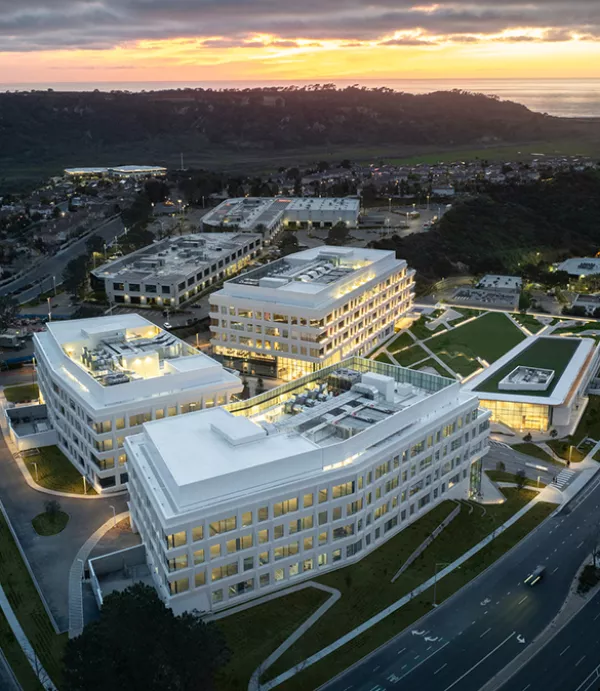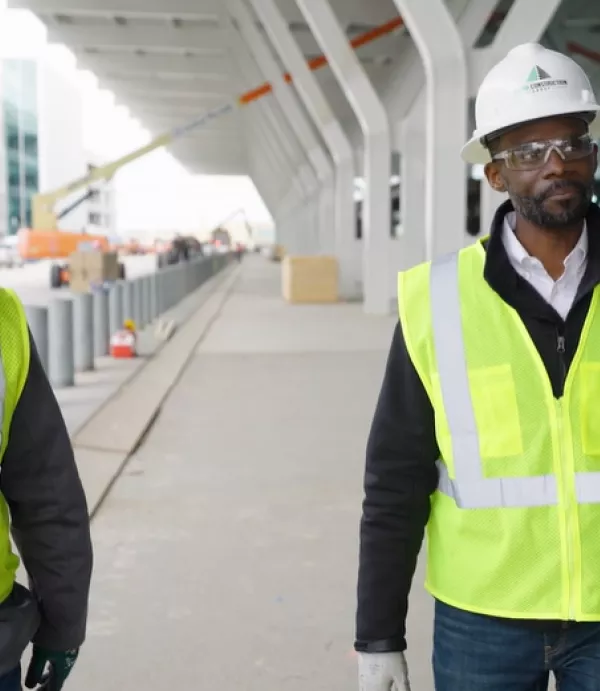Port of the Future: San Ysidro Land Port of Entry Combines Security with Durability and Performance to Set New Standard
April 10, 2020

In 2007, the San Diego Regional Association of Governments (SANDAG) released the results of a study on the ramifications of border crossing delays on the United States and Mexico economies. It was reported that border congestion precipitated a loss of $7.7 billion in gross output. Meanwhile, cross-border pedestrian and vehicular traffic was projected to increase exponentially, 85% and 87% respectively, presenting imminent impacts on the region’s safety and security.
To tackle these issues, the U.S. General Services Administration (GSA), in partnership with the U.S. Customs and Border Protection (CBP), embarked on an ambitious 10-year, multi-phased expansion and renovation project to the San Ysidro Land Port of Entry, the busiest land port of entry on the western hemisphere.
That pivotal project is now complete with Atkinson/Clark’s delivery of the last phase of its modernization program. The Atkinson/Clark team celebrated alongside GSA, CBP, and numerous other federal, state, and city leaders at the ribbon-cutting of this landmark project in December.
After more than three years of construction and nearly one million worker hours, Atkinson/Clark completed work on a new southbound vehicular operations facility and employee parking structure; an expanded northbound vehicular operations facility; improved access roads, security fencing, and site lighting; and upgraded geoexchange, video surveillance, and stormwater management systems. Most impressively, this extensive scope of work was achieved with minimal interruptions to port operations.
Next Level Complexity
The level of coordination required to build the 16-acre project within the 52-acre campus was unprecedented, involving eight federal, state, and city agencies, as well as the Marines and the National Guard – not to mention a bi-national collaboration with the Mexican government.
One of the more difficult components of the job was executing a 57-hour closure of the southbound lanes of traffic on I-5 and I-805, which allowed the team to demolish an existing canopy, remove crash barriers and old striping, and install new striping and utility lines. Shutting down a freeway is a big deal in traffic-weary Southern California. So when news spread that five miles of these heavily-travelled lanes (50,000 vehicles pass through each day) would be closed for two days, people predicted a “carmaggedon.” The team proved naysayers wrong by executing the closure sans chaos, finishing 12 hours earlier than scheduled.
This success was the result of a year of planning with almost surgical precision. A portion of the work extended beyond that actual five-mile stretch of freeway. From orchestrating trolley and bus schedules and organizing tow trucks, to running radio advertisements and interfacing with the media, there were myriad details that demanded attention and action. Confident in their meticulous preparations and ability to perform as one tightly-choreographed unit, the team executed their plan and re-opened the newly aligned and much improved I-5 southbound lanes.
The most distinguishing visual element of the project is a 750-foot-long catenary-suspended canopy above the vehicle inspection booths. The steel and ethylene tetrafluoroethylene (ETFE) canopy affords uninterrupted sightlines and much-needed illumination for officers as they perform inspections. It also serves as a canvas for “Double Horizon,” an art installation comprised of LED lights that graces the length of the southern side of the canopy.
Much like a suspension bridge, the design and installation of this 200-ton canopy called for precise planning and coordination with numerous stakeholders. Atkinson/Clark and the design team spent time in the final manufacturer’s production facility to work with the cable, node, and ETFE manufacturers to ensure rapid installation of the various components on site. The erection sequence was meticulously plotted, starting with a foundation 6 feet deep and 50 feet long with a 17-foot wide pile cap requiring 20,000 pounds of rebar in mast, then filled with concrete. The canopy was then installed with a jacking system, lifted with two crawler cranes.
Safety and Security
The heightened presence of military and law enforcement on site became routine as the national conversation on immigration and trade intensified over the course of the project. The team was nimble, adapting to constantly-evolving site conditions. The team deployed strategies to ensure the highest level of safety and security of port employees, the general public, and the men and women working on site. Constant communication with CBP, the Marines, and the National Guard, was essential to maintaining both port operations and public safety.
To accommodate daily schedule shift changes for hundreds of port employees, the team designed alternate routes to segregate and direct employees safely and expeditiously. Multilingual notice boards installed at key nodes on site indicated current open paths for pedestrians and drivers. Temporary structures and barriers separated port employees and the public from construction activities. In addition to providing regular updates on construction timelines and closures on their public website, the team’s information protocol also included town hall meetings.
The Atkinson/Clark team also formed a maintenance of traffic (MOT) taskforce that convened weekly to evaluate current site conditions, develop traffic plans in support of staged construction, and define procedures necessary for execution. This approach mitigated impacts to traffic flow while maintaining the highest degree of safety.
A History of Collaboration
This successful project delivery was the culmination of a carefully-cultivated relationship that formed eight years prior when Atkinson/ Clark completed Phase 1A of the GSA’s expansion program, a $12-million pedestrian bridge spanning the I-5 freeway. The cast-in-place bridge includes nine piers with exposed architectural concrete, 2,400 feet of stainless steel handrails, two cast-in-place elevated approach ramps, two structural steel approach bridges, and an exposed soffit concrete stair. Despite tight laydown areas and a site divided by the 30-lane highway, ongoing CBP operations were never interrupted during construction. The team completed the project three months ahead of schedule, laying the groundwork for a strong partnership with GSA.
Their experience during Phase 1A guided the team as they executed the much broader scope of work for Phase 3. Innovation, collaboration, and transparency continued to be the hallmarks of the project. The mutual respect and trust between owner and builder strengthened as they coalesced into one team, all working toward a common goal.
Thinking Big with Small Business
The huge economic impact of this project on an entire region inspired the team to maximize opportunities for small business. The team deployed a proven strategy throughout procurement, reaping robust small business participation. Through various outreach events and by tapping into connections made through Clark’s innovative Strategic Partnership Program, the team awarded more than $82 million in contracts to local small business.
The Case for Going Green
The new SYLPOE was envisioned as a “Port of the Future,” with enhanced features that promote efficiencies, operations, security, and safety. A big part of that vision was the foresight to invest in sustainable and renewable elements that would lower operational costs while reducing the carbon footprint.
The SYLPOE Phase 3 project is on track to achieve a LEED Platinum rating, the highest certification awarded by the U.S. Green Building Council. Sustainable features of the new port of entry include multifaceted strategies for solar, water, and heat recycling, equating to a projected $34 million in cost savings over the next 40 years.
The Next Chapter
Before construction, wait times at the border in San Ysidro averaged more than 90 minutes. Today, with 34 lanes guiding motorists into 63 vehicle inspection booths, traffic flow has dramatically improved. Add in the additional pedestrian crossing sites, and the result is considerably shorter wait times.
GSA is always looking to enhance the border crossing experience and has now set its sight nine miles east of San Ysidro to the Otay Mesa Land Port of Entry, the busiest commercial port in California. Fresh off their success at SYLPOE, the Atkinson/Clark team is gearing up for the next chapter of their partnership with GSA and CBP; they were recently awarded a design-build contract for the modernization of the Otay Mesa LPOE. Project development efforts are currently underway, with construction scheduled to begin in June of 2020.


